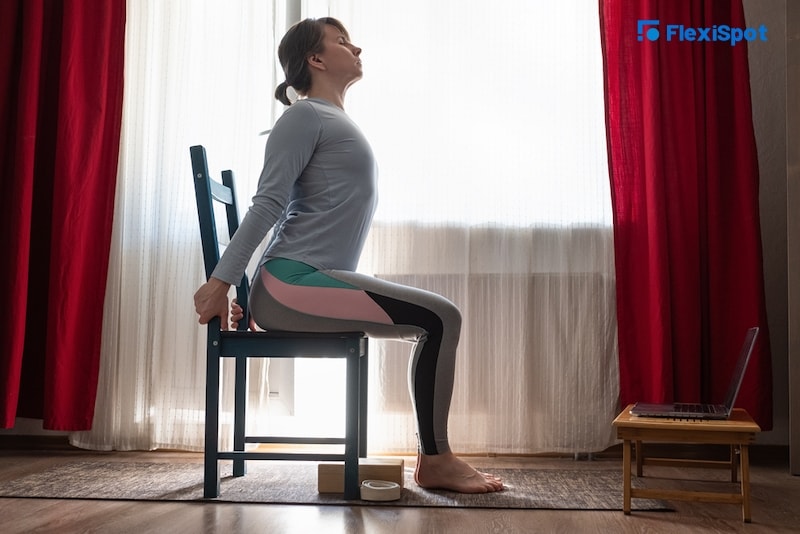Posture training can be a great adjunct to any exercise program. However, when most people think of posture they usually just squeeze their shoulder blades together. It is easy forget that posture is about full body balance (see Spine Anatomy 101 here to get a better idea). When the entire body is in sync it makes it easy for bones, ligaments and muscles to work together and stay pain free, now and in the future.
To get all the necessary components involved, try these 5 simple exercises for posture training:
1. Chin tucks.
This exercise is best started on the floor to master good form before making it harder in sitting or standing. A major part of poor posture is a forward head. This position stretches the muscles in the front of the neck and makes them weak, while pinching the muscles at the back of the skull and making them tight. Training the head to maintain a better position will help negate these issues.
Lie flat on your back in a comfortable position. You can support the back of the head with a small rolled towel or flat pillow (if needed) at the base of the skull (NOT on the neck itself). Then, tuck your chin toward your chest. Think about trying to give yourself a "double chin" while keeping your head resting on the floor and shoulders relaxed (this is a common compensation to avoid). Try holding the position for 5 seconds and build to 10 seconds. Work up to 10 repetitions 1-3 times throughout the day. You can progress to the wall and then with no support as you start to understand the correct position and how it should feel.
2. Shoulder blade squeezes.
This is the component of posture training that most of us do automatically, however you probably need to change your focus. There are two parts to posture when it comes to the shoulder blades. The first is having the shoulder blades close enough to the spine (two inches from the spine: see picture below). The second part is keeping the shoulders themselves from slouching too far forward. We tend to focus on the first more than the second component. This over exaggerated squeezing of the blades together will feel unnatural. Try this instead:
Imagine a quarter between the lowest part of the shoulder blades. To hold it there, you will bring your shoulder blades together while you also gently push the chest forward. Your head and shoulders should feel balanced and well stacked. Try holding for 5 seconds and build to 10 seconds as you can. Work up to 10 repetitions 1-3 times throughout the day. Make sure you aren't arching your back (see the next exercise) as you do this and keep your neck relaxed.
3. Pelvic tilts.
When posture training, don't forget to keep the entire spine in alignment through proper control of the pelvis and low back. Specific movement in the low back can feel stiff and poorly coordinated at first but will get easier with time.
Sitting on the edge of a chair with the arms in a comfortable position (try them on your knees), start by slowly arching the back as far you can. Then, gradually move in the opposite direction as if you are tucking your tail. Slowly roll back and forth for a count of two in each direction. Roll back and forth 10 times 1-3 times throughout the day.
As you practice you should notice a comfortable "middle ground" that your body wants to stay in. It will be slightly different for everyone so listen to your body. This is where you should try to keep your low back aligned as much as possible during the day when you're statically positioned (i.e. at a standing desk). If you're struggling you may need to focus on building some core strength and control with these first.
4. Shoulder Rolls.
As you focus on these posture training exercises, it can be easy to get too tensed up in the neck and shoulders. It can help to "reset" and relax, since good posture should be comfortable.
Start by bringing the shoulders to the ears, then let all the tension in your upper body go as you let your shoulders drop back down and slightly back as far as they will go. Repeat up to 10-30 times throughout the day. BONUS: accompany with rhythmic deep breathing to promote re-focus on your daily tasks, relaxation and circulation.
5. Putting all together: The wall sit.
Now that you've practiced the top four exercises and feel like pro, you can put it all together. This is an advanced move that may feel awkward at first while first exercising but will get significantly easier with time.
First, find a wall. With the feet 6-12 inches from the wall, focus on getting the butt, mid back, back of the shoulders and back of the head to touch the wall. It is normal to have a small space that the hand can fit through in the low back and neck. Your line of vision should not feel skewed if your chin is adequately tucked. Hold up to 60 seconds, 1-3 times throughout the day. If it's too hard, awkward or you feel tense, return to the first four and come back to this when you feel more comfortable. You can then build to practicing without the wall when you feel ready.
Good posture is a great prevention tool for onset of back and neck pain, especially at work. Now that you have all the muscles working, focus on holding it throughout the day. Try setting reminders or making a team goal in the office. Consistency is key as you build good postural habits. With these 5 simple exercises for posture, your spine will thank you!






